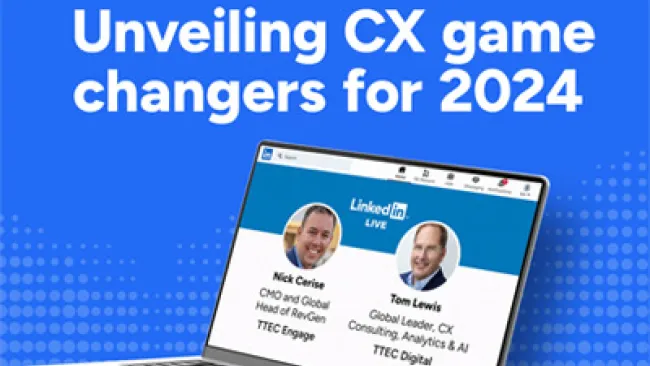When we started reporting on virtual reality (VR) in 2016 we were picking up cardboard goggles, retailers began to feature virtual storefronts, and experts questioned its relevance in day-to-day life.
Flash forward to 2022: A global pandemic, a Metaverse (estimated to be worth $800 billion by 2024), and a huge investment in simulated gaming has catapulted the virtual market.
But how did we get here?
Let’s explore six years of TTEC editorial content on VR and augmented reality (AR) technology to look back on what we got right and wrong in this rapidly evolving market.
Virtual shopping becomes a reality
Oct. 11, 2016
Steve Brennen, eBay Australia’s Senior Director of Marketing and Retail Innovation, opened up about launching the world’s first VR department store. The virtual storefront used a VR headset to browse a simulated storefront with product information, price and inventory.
CX experts were just starting to see what virtual reality meant for the future of retail.
What we got right:
VR will go beyond the entertainment and gaming industry. Brennan cited virtual technology giving platforms more credibility and confidence. Acting as a bridge between online and offline shopping experiences, the VR department store was a launching point for how leading brands use virtual technology today.
What we got wrong:
We still haven’t reached the point where a mainstream population of customers are replacing digital and physical shopping with VR. Virtual reality is a great tool to digitally immerse customers in a store, especially during a pandemic, but we have seen AR technology take more of a role with exploring products. The simple use of a smartphone to scan a room or virtually trying a product (Ikea and Warby Parker) has been more user and wallet friendly.
Emotions powers technology adoption
Sept. 8, 2017
VR was still finding its feet. Popular AR games like Pokémon Go were fizzling out and sales figures of VR headsets were “not exciting” and lacking a consumer experience.
Two Forrester analysts, Anjali Lai and Juan Salazar quoted from their report on technology engagement, “Our analysis suggests that despite enchanting consumer initially, virtual reality in its current form does not create the emotionally fulfilling consumer experience needed to change long-term behavior.” Suffice to say, it had room to grow and hearts to win over.
What we got right:
Technology must have purpose. We have seen this with chatbots and AI. If a brand introduces a new technology for the sake of it being shiny and new, users may be put off. Brands who win with VR use it to educate and immerse customers in their products. It builds a genuine relationship with customers who cannot visit in-person but want the same experience
What we got wrong: Experts believed VR sales may have a rocky future. In Q3 of 2017, the Oculus Rift model, now a division of Facebook (therefore the Metaverse) only sold 210,000 models, according to findings from Canalys.
The newest model, Oculus Quest 2, now sold nearly 1.87 models from Oct. 2020 to Q1 of 2021 according to Statistia, with a large percentage during the holiday season. This is a big leap to the time when VR the technology was just starting to obtain mainstream use.
It remains to be seen if the buzz behind Metaverse will send organizations into a virtual gold rush to push more products and marketing into a growth VR audience.
Customer experience lessons from CES 2018
Jan. 31, 2018
At the Consumer Electronics Show in Last Vegas, we handled the latest in VR technology with a completely immersive, music-based game called Rhythm of the Universe. It was a new, challenging, and exciting change from traditional video games.
What we got right:
Immersion is the name of the game. VR offers up a hyper-personalized and individual journey for users. A big charm of the game and with VR in general is users can explore and innovate in their own world, at their own pace.
What we got wrong:
The user can’t always be left to their own devices. If the VR product creates roadblocks or friction for the user, the resulting experience will be noticeably unpleasant. Before release, especially for retailers, VR game technology needs to allow enough exploration without too much of a learning curve for users.
How VR and AR will shape employee training
Aug. 30, 2019
&
Enter a new reality of virtual training
Jan 15, 2020
VR and AR technology can reshape employee training and learning. New role-playing scenarios now provide real-time feedback for everyday activities such as workplace protocol, difficult customer interactions, and equipment management.
What we got right:
VR can be an incredibly effective mentoring tool. Key practices we have already seen put into play are conversational, process-based, and object-based training scenarios that encourage a stress-free but hands-on, approach to their equipment and work life. Survey results from PwC shows VR learners were 275% more confident to apply skills learned after training.
What we got wrong:
The ease of access and cost of VR equipment is another obstacle for mainstream adoption. From the start of 2016, experts have weighed in on the high price tag of virtual reality and its return on investment. And despite VR equipment becoming affordable, extensive employee experience thought leadership is needed to decide if the move is right.
It also goes without saying the effects of the pandemic and how it may prevent equipment sharing and in-office access.
Here’s why this entrepreneur is excited about CX
Apr. 15, 2021
We spoke with Zain Jaffer, an entrepreneur and investor focused on startups and property tech, on how digital efforts can evolve past the pandemic. He discussed how VR and AR are innovating in the retail space to provide personalized and informative experiences for users.
What we got right:
VR and AR are fantastic personalization tools. Leading brands like Nike experimented with 3D models to replicate an in-store experience when in-store wasn’t always doable. Those quick to digitize moments that matter to customers were able to turn experiences into sales opportunities.
What we got wrong:
Our earlier writing placed more an emphasis on VR over AR. Jaffer painted a picture of AR being more applicable to retail and hardware brands, with an emphasis on the ease of viewing objects through a phone over a headset.
AR remains as an affordable and user-friendly alternative to everyday customer experiences that need quick visualizations such as how does this couch look in this corner or how does this style of glasses look.
Virtual CX looks forward in 2022
With the virtual and augmented reality market is expected to grow to 600 billion by 2025, the new year is already laying the groundwork for innovation. The heightened ambitions of the Zuckerberg’s Metaverse, return to in-person, and growth of VR gaming has revamped the potential of this technology. How industry leaders approach these changes can define another six years of incredible growth.















